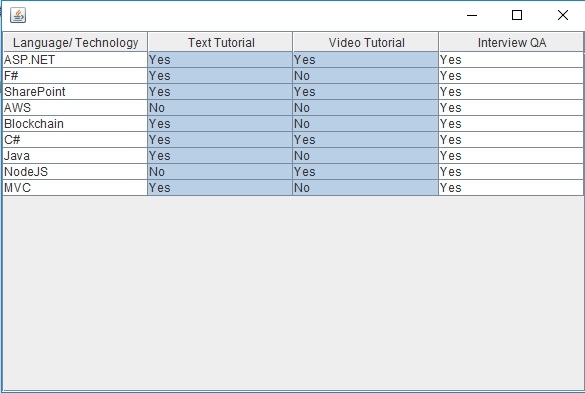
 Data Structure
Data Structure Networking
Networking RDBMS
RDBMS Operating System
Operating System Java
Java MS Excel
MS Excel iOS
iOS HTML
HTML CSS
CSS Android
Android Python
Python C Programming
C Programming C++
C++ C#
C# MongoDB
MongoDB MySQL
MySQL Javascript
Javascript PHP
PHP
- Selected Reading
- UPSC IAS Exams Notes
- Developer's Best Practices
- Questions and Answers
- Effective Resume Writing
- HR Interview Questions
- Computer Glossary
- Who is Who
Java program to deselect a range of columns in a JTable
In this article, we will learn how to deselect a range of columns in a JTable using Java. JTable is a part of the Swing framework in Java, which is used to display and edit tables. Sometimes, we may want to deselect a specific range of columns after selecting columns in a table. This can be done by using the removeColumnSelectionInterval() method.
Problem Statement
Given a JTable with columns selected, write a Java program to deselect a range of columns from the table.
Input
A JTable with columns selected.Output
The specified range of columns will be deselected.
Steps to deselect a range of columns in JTable
Following are the steps to deselect a range of columns in JTable ?- Import the necessary classes from javax.swing and javax.swing.table packages.
- Create a JTable with a default table model and some rows and columns of data.
- Use the addColumnSelectionInterval() method to select a range of columns.
- Use the removeColumnSelectionInterval() method to deselect a specific range of columns.
- Display the table in a JFrame to observe the result.
The selected range of columns using addColumnSelectionInterval() is shown in the demo screenshot ?

Java program to deselect a range of columns in a JTable
The following is our example of deselecting a range of columns ?
package my;
import javax.swing.JFrame;
import javax.swing.JScrollPane;
import javax.swing.JTable;
import javax.swing.table.DefaultTableModel;
public class SwingDemo {
public static void main(String[] argv) throws Exception {
DefaultTableModel tableModel = new DefaultTableModel();
JTable table = new JTable(tableModel);
tableModel.addColumn("Language/ Technology");
tableModel.addColumn("Text Tutorial");
tableModel.addColumn("Video Tutorial");
tableModel.addColumn("Interview QA");
tableModel.addRow(new Object[] { "ASP.NET", "Yes", "Yes", "Yes"});
tableModel.addRow(new Object[] { "F#", "Yes", "No", "Yes"});
tableModel.addRow(new Object[] { "SharePoint", "Yes", "Yes", "Yes"});
tableModel.addRow(new Object[] { "AWS", "No", "No", "Yes"});
tableModel.addRow(new Object[] { "Blockchain", "Yes", "No", "Yes"});
tableModel.addRow(new Object[] { "C#", "Yes", "Yes", "Yes"});
tableModel.addRow(new Object[] { "Java", "Yes", "No", "Yes"});
tableModel.addRow(new Object[] { "NodeJS", "No", "Yes", "Yes"});
tableModel.addRow(new Object[] { "MVC", "Yes", "No", "Yes"});
table.setColumnSelectionAllowed(true);
table.addColumnSelectionInterval(1, 2);
table.setRowSelectionAllowed(false);
table.removeColumnSelectionInterval(1, 2);
JFrame f = new JFrame();
f.setSize(600, 400);
f.add(new JScrollPane(table));
f.setVisible(true);
}
}
Output

Code Explanation
In this program, we create a JTable with a default table model and add columns like "Language/Technology", "Text Tutorial", "Video Tutorial", and "Interview QA". We then populate the table with data. After enabling column selection, we select columns 1 and 2 using addColumnSelectionInterval(). Later, we deselect these columns using removeColumnSelectionInterval(). The table is displayed in a JFrame for visual confirmation.

